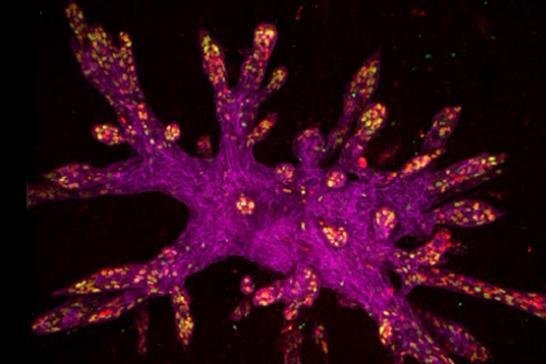Reseachers grew functioning breast tissue, seen above, using a hydrogel they designed that allows cells to be exposed to hormones, leading them to arrange, grown and differentiate as they do in the developing human breast. Photo by Whitehead Institute for Biomedical Research
CAMBRIDGE, Mass., March 2 (UPI) -- Breast cancer research often relies on tumor cells implanted in mice or isolated samples from patients, neither of which mimic the full cellular environment of the human breast, which researchers say has limited what can be discovered in the lab.
In an effort to grow breast tissue for research, scientists at the Whitehead Institute for Biomedical Research created a hydrogel scaffold that allows breast samples grow into functional human tissue.
Tumors rely on the cells and environment around them, growing and reacting to what's around them. The differences between mammary tissue in humans and mice are significant, and isolated samples don't show the way cell interaction, including responses to hormones, triggers cancer or how it progresses.
Scientists already have created mini-brains, mini-intestines and mini-stomachs for research, but breast tissue has been difficult to keep alive after it has grown.
"I wouldn't have thought it possible that these tissues could grow with such complexity and to such a size," Dr. Piyush Gupta, a researcher at the Whitehead Institute and assistant professor of biology at the Massachusetts Institute of Technology, said in a press release. "It's really quite remarkable."
Based on the idea that molecules from surrounding cells in breast tissue were required for mammary cells to direct their development, the researchers designed a hydrogel scaffold containing extracellular proteins and carbohydrates in mammary tissue they thought would allow the cells to develop into functioning tissue.
When the scaffolds were seeded with primary human epithelial cells, the cells self-organized, grew, and differentiated into the types of cells found in mammary tissue, the researchers write in a study published in the journal Breast Cancer Research. The tissues contained types of breast stem cells, in their correct position, forming into ductal and lobular tissues that responded when treated with estrogen, progesterone and prolactin-produced lipid droplets.
Breast cells implanted in the scaffold at 7 days, left, and 11 days, right, after seeding. Photo by Whitehead Institute for Biomedical Research
"It's a very good tool for someone who has questions about normal breast development or breast cancer -- to see what happens when a gene is perturbed," said Ethan Sokol, a reseacher at the Whitehead Institute.
















